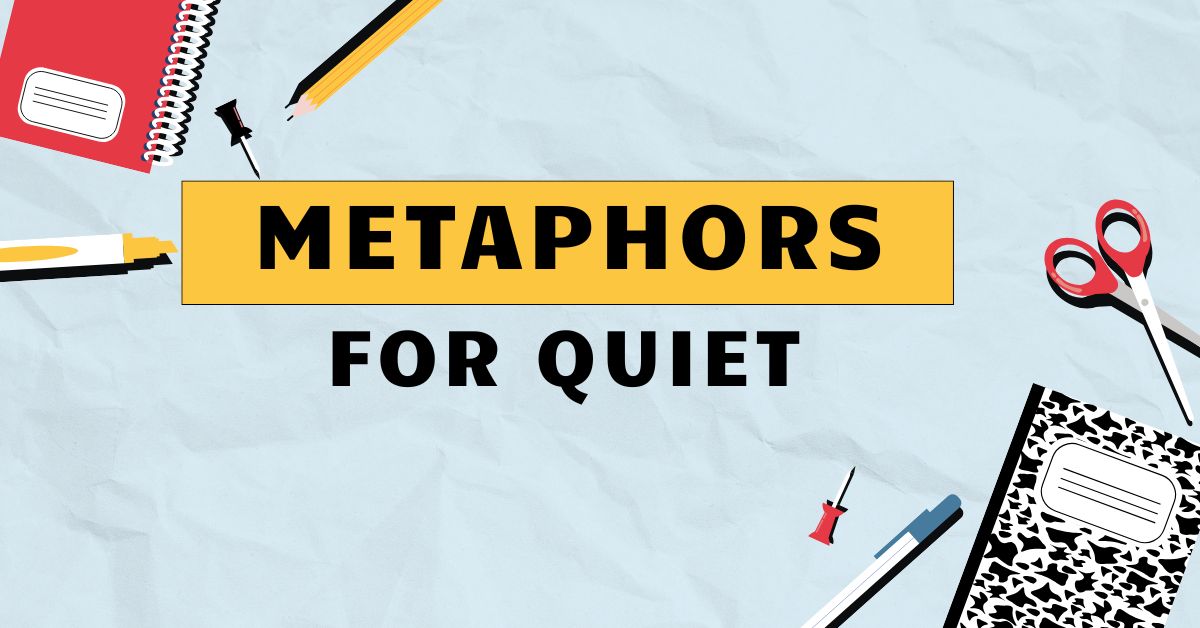40 Metaphors for Quiet: A Comprehensive Guide
Understanding metaphors for ‘quiet’ enhances our ability to appreciate nuanced expressions in literature, poetry, and everyday language. This exploration delves into various metaphors that capture the essence of silence, stillness, and the absence of noise.
This article is beneficial for English language learners, writers seeking evocative language, and anyone interested in the art of figurative speech. By mastering these metaphors, you’ll enrich your vocabulary and gain a deeper understanding of how language shapes perception.
Table of Contents
- Introduction
- Definition of Metaphor for Quiet
- Structural Breakdown
- Types and Categories of Metaphors for Quiet
- Examples of Metaphors for Quiet
- Usage Rules
- Common Mistakes
- Practice Exercises
- Advanced Topics
- FAQ
- Conclusion
Definition of Metaphor for Quiet
A metaphor for “quiet” is a figure of speech that describes silence or the absence of noise by comparing it to something else that shares similar characteristics. Unlike similes, which use “like” or “as,” metaphors directly equate quiet with another concept, creating a more vivid and imaginative comparison.
These metaphors help convey the depth, feeling, and impact of quietness in a way that literal language often cannot. Understanding the subtleties of these metaphors allows speakers and writers to evoke a stronger sense of stillness and tranquility.
The function of a metaphor for ‘quiet’ is to enrich language, evoke emotions, and create vivid imagery. They are frequently used in literature, poetry, and even everyday conversation to describe the quality and impact of silence.
These metaphors go beyond simply stating that something is quiet; they suggest the *kind* of quiet being experienced, whether it’s peaceful, eerie, expectant, or oppressive. Furthermore, these metaphors allow for a more subjective and nuanced understanding of the concept, as each comparison brings its own set of associations and connotations.
Metaphors for quiet can be found in various contexts, including literature, poetry, film, and everyday conversation. In literature, they are often used to set a mood or atmosphere.
For example, a writer might describe a forest as being “a cathedral of silence” to convey its solemn and awe-inspiring stillness. In film, visual metaphors can be used to represent quiet, such as a shot of a still lake reflecting the sky.
In everyday conversation, people might use metaphors to emphasize the intensity of the quiet, such as saying “you could hear a pin drop” to describe a completely silent room. The ability to recognize and use these metaphors effectively is a key aspect of language proficiency.
Structural Breakdown
The structure of a metaphor for quiet typically involves two main elements: thetenor(the subject being described, which is ‘quiet’) and thevehicle(the object or concept to which quiet is being compared). The vehicle lends its characteristics to the tenor, creating the metaphorical meaning.
The connection between the tenor and vehicle is not a literal one but is based on shared qualities or associations. This indirect comparison is what makes a metaphor a powerful tool for expression.
For example, in the metaphor “The night was a velvet hush,” the tenor is the ‘quiet’ of the night, and the vehicle is ‘velvet’. Velvet, with its soft and smooth texture, suggests a gentle, encompassing silence.
The shared quality is the feeling of being enveloped or covered in something comforting. This structure allows the metaphor to convey a sense of peaceful and luxurious quiet.
The effectiveness of the metaphor depends on the audience’s understanding of the associations with the vehicle, which in this case is the tactile and emotional qualities of velvet.
Understanding the underlying structure of metaphors for quiet can help in both interpreting and creating them. One can analyze a metaphor by identifying the tenor and vehicle, and then exploring the connection between them.
When crafting a metaphor, consider what qualities of ‘quiet’ you want to emphasize and choose a vehicle that effectively conveys those qualities. The more vivid and apt the vehicle, the more powerful the metaphor will be.
The strength of a metaphor lies in its ability to illuminate aspects of the tenor (quiet) through the lens of the vehicle, creating a richer and more evocative understanding.
Types and Categories of Metaphors for Quiet
Metaphors for quiet can be categorized based on the source of the comparison, offering a more structured understanding of their diverse forms.
Nature-Related Metaphors
These metaphors draw comparisons between quiet and elements of nature. They often evoke feelings of peace, tranquility, or the sublime.
Examples include: “The silence was a blanket of snow,” “The forest was a cathedral of quiet,” “The stillness of the lake was a mirror reflecting the sky,” “The night was a velvet hush,” or “The desert held a profound silence.” These metaphors capitalize on the inherent associations people have with natural landscapes and phenomena, using them to articulate the qualities of quiet.
Object-Related Metaphors
These metaphors compare quiet to inanimate objects, often highlighting the sense of stillness, containment, or absence of sound.
Examples include: “The room was a tomb of silence,” “The library was a sanctuary of quiet,” “The old house held a stillness like a forgotten clock,” “His voice dropped into a well of silence,” or “The city after the storm was a museum of quiet.” These comparisons often focus on the physical properties or functions of the objects to create a sensory and evocative impression of quiet.
Abstract Metaphors
These metaphors use abstract concepts to describe quiet, often focusing on its emotional or psychological impact.
Examples include: “The silence was a heavy cloak,” “Quiet was a palpable presence,” “The stillness was a fragile hope,” “Silence became a thick, suffocating blanket,” or “Quiet was a deep, echoing void.” These metaphors delve into the intangible aspects of silence, emphasizing its power to affect emotions, create atmosphere, or symbolize deeper meanings.
Animal-Related Metaphors
These metaphors use the characteristics or behaviors of animals to convey the qualities of quiet.
Examples include: “The night was as quiet as a sleeping mouse,” “The forest was hushed, like a waiting predator,” “She moved with the silence of a stalking cat,” “The auditorium was as still as a hibernating bear,” or “The meeting ended with the quiet of a flock of birds suddenly taking flight.” These metaphors often draw on the intuitive understanding of animal behavior to create a vivid and relatable image of quiet.
Sensory Metaphors
These metaphors use other senses (sight, touch, taste, smell) to describe the experience of quiet, creating synesthetic imagery.
Examples include: “The silence felt like a soft blanket,” “Quiet tasted like unsweetened tea,” “The stillness was a cool, smooth stone,” “The quiet smelled like fresh snow,” or “The silence looked like a vast, empty canvas.” These metaphors blend sensory experiences to create a more immersive and imaginative understanding of quiet, appealing to multiple senses simultaneously.
Examples of Metaphors for Quiet
This section offers a comprehensive collection of metaphors for quiet, organized by category, to illustrate their diverse applications and enhance comprehension.
Nature Metaphors
The following table provides examples of how nature-related metaphors can be used to describe quiet.
| Metaphor | Explanation |
|---|---|
| The forest was a cathedral of quiet. | Compares the forest’s stillness to the reverent silence of a cathedral. |
| The silence was a blanket of snow. | Suggests a heavy, all-encompassing quiet, like fresh snowfall. |
| The lake was a mirror of stillness. | Implies a reflective, undisturbed quiet, like a calm lake. |
| The night was a velvet hush. | Describes a soft, luxurious quiet, like smooth velvet. |
| The desert held a profound silence. | Indicates a deep, significant quiet, typical of vast deserts. |
| The meadow was a sea of tranquility. | Compares the meadow’s quiet to the calming vastness of the sea. |
| The mountains stood in silent vigil. | Suggests a watchful, solemn quiet, like mountains standing guard. |
| The dawn arrived with a whisper of quiet. | Describes a gentle, almost inaudible quiet at the beginning of the day. |
| The cave was a womb of silence. | Implies a protective, enclosed quiet, like a mother’s womb. |
| The woods were draped in a cloak of quiet. | Suggests a surrounding, concealing quiet, like a cloak. |
| The valley slumbered in quiet repose. | Describes a peaceful, resting quiet, like someone asleep. |
| The air hung heavy with silence. | Suggests a dense, palpable quiet that fills the atmosphere. |
| The stars watched in quiet contemplation. | Implies a thoughtful, observing quiet, like stars gazing down. |
| The moon bathed the landscape in silent light. | Describes a quiet illuminated by the moon’s gentle glow. |
| The river flowed in quiet determination. | Suggests a steady, unwavering quiet, like a river’s current. |
| The garden breathed a quiet sigh. | Compares the garden’s stillness to a gentle, relaxed exhale. |
| The clouds drifted in silent parade. | Implies a slow, majestic quiet, like clouds moving across the sky. |
| The ocean whispered secrets in the quiet. | Suggests a mysterious, intimate quiet, like ocean waves murmuring. |
| The wind carried the quiet through the trees. | Describes quiet being transported and spread by the wind. |
| The earth absorbed the noise into a blanket of quiet. | Implies a quiet that consumes and neutralizes all sound. |
Object Metaphors
The following table provides examples of how object-related metaphors can be used to describe quiet.
| Metaphor | Explanation |
|---|---|
| The room was a tomb of silence. | Compares the room’s quiet to the profound stillness of a tomb. |
| The library was a sanctuary of quiet. | Implies a protected, peaceful quiet, like a safe haven. |
| The old house held a stillness like a forgotten clock. | Suggests a timeless, undisturbed quiet, like an unused clock. |
| His voice dropped into a well of silence. | Describes a deep, echoing quiet, like the bottom of a well. |
| The city after the storm was a museum of quiet. | Indicates a preserved, almost artificial quiet, like a museum exhibit. |
| The church stood as a beacon of quiet. | Compares the church’s stillness to a guiding light in a noisy world. |
| The classroom was a box of quiet anticipation. | Suggests a contained, expectant quiet, like a closed box. |
| The theater waited in silent darkness. | Implies a dramatic, suspenseful quiet before a performance. |
| The book held the secrets of quiet within its pages. | Describes quiet as something hidden and valuable, like knowledge. |
| The photograph captured a moment of perfect quiet. | Suggests a frozen, unchanging quiet preserved in time. |
| The antique mirror reflected only quiet. | Implies a reflective, introspective quiet, devoid of distractions. |
| The abandoned factory was a shell of quiet. | Describes an empty, desolate quiet, like an abandoned building. |
| The empty swing set was a monument to quiet. | Suggests a nostalgic, melancholic quiet, like a forgotten playground. |
| The dusty attic held the ghosts of quiet. | Implies a lingering, eerie quiet associated with the past. |
| The grandfather clock ticked away in quiet solitude. | Describes a solitary, rhythmic quiet, punctuated by the clock’s ticking. |
| The painting depicted a scene of serene quiet. | Suggests a peaceful, harmonious quiet captured in art. |
| The musical instrument rested in quiet anticipation. | Implies a potential, waiting quiet before music begins. |
| The sculpture stood as a symbol of quiet strength. | Describes a powerful, unwavering quiet embodied in art. |
| The old typewriter held the stories of quiet within its keys. | Suggests a creative, expressive quiet waiting to be written. |
| The locked diary kept the secrets of quiet hidden away. | Implies a private, personal quiet protected from the outside world. |
Abstract Metaphors
The following table provides examples of how abstract metaphors can be used to describe quiet.
| Metaphor | Explanation |
|---|---|
| The silence was a heavy cloak. | Compares the silence to a burdensome garment, suggesting oppression. |
| Quiet was a palpable presence. | Implies that the quiet could be felt physically, like a tangible force. |
| The stillness was a fragile hope. | Suggests that the quiet was delicate and easily broken, like hope. |
| Silence became a thick, suffocating blanket. | Describes a dense, overwhelming quiet that is hard to escape. |
| Quiet was a deep, echoing void. | Indicates an empty, resonant quiet, like a bottomless space. |
| The quiet was a pregnant pause. | Compares the quiet to a moment full of unspoken meaning and anticipation. |
| Silence was a loaded gun. | Suggests a dangerous, volatile quiet that could explode at any moment. |
| The quiet was a velvet curtain. | Implies a smooth, luxurious separation from the outside world. |
| Quiet was a secret language. | Describes a quiet that conveys meaning beyond words, like a hidden code. |
| Silence was a wall between them. | Suggests a barrier of unspoken feelings and distance. |
| The quiet was a pool of reflection. | Implies an introspective space for thought and contemplation. |
| Silence was a bridge to understanding. | Describes a quiet that allows for deeper connection and empathy. |
| The quiet was a canvas for dreams. | Suggests a blank space where imagination can flourish. |
| Silence was a dance of unspoken words. | Implies a subtle, expressive communication without verbal language. |
| The quiet was a song of the soul. | Describes a deep, emotional expression through stillness. |
| The quiet was a shield against the world. | Compares the quiet to a protective barrier, offering safety and solitude. |
| Silence was a mirror reflecting inner thoughts. | Suggests an introspective quiet that reveals one’s true self. |
| The quiet was a breath of fresh air. | Implies a refreshing, revitalizing escape from noise and chaos. |
| Silence was a heavy weight on their hearts. | Describes a burdensome, emotional quiet filled with sadness or regret. |
| The quiet was a tapestry woven with unspoken emotions. | Suggests a complex, intricate quiet layered with feelings and memories. |
Usage Rules
When using metaphors for quiet, it’s important to ensure that the comparison is both apt and effective. The vehicle should resonate with the reader and evoke the desired imagery.
Avoid clichés and strive for originality to create a more powerful impact. Consider the context and the overall tone of your writing when choosing a metaphor.
A metaphor that works well in a poem might not be appropriate for a technical report.
Consistency is key.Once you establish a metaphorical framework, maintain it throughout your writing. Mixing metaphors can confuse the reader and weaken the overall effect.
For example, if you start by describing quiet as a “blanket of snow,” avoid switching to a metaphor that portrays it as a “roaring fire.” The two images are contradictory and will undermine the impact of your writing.
Clarity is also crucial.While metaphors are inherently indirect, they should still be understandable. If the connection between the tenor and vehicle is too obscure, the metaphor will fail to communicate its intended meaning.
Test your metaphors on others to ensure that they are clear and effective. A well-crafted metaphor can elevate your writing and provide deeper insight into the experience of quiet.
Common Mistakes
One common mistake is using mixed metaphors, which occur when two or more incompatible metaphors are combined. This can create confusing and nonsensical imagery.
Incorrect: “The silence was a roaring blanket, engulfing the room in its soft flames.” (Combines the contradictory images of a ‘roaring’ sound and a ‘soft’ blanket.)
Correct: “The silence was a heavy blanket, smothering the room.” (Maintains a consistent image of a heavy, oppressive silence.)
Another common mistake is using clichéd metaphors, which are overused and lack originality. These metaphors have lost their impact and can make your writing seem uninspired.
Incorrect: “The silence was deafening.” (A common cliché that has lost its impact.)
Correct: “The silence pressed against my ears, a tangible weight.” (A more original and evocative description of silence.)
Finally, it’s important to avoidoverly complex or obscure metaphors. While creativity is important, the connection between the tenor and vehicle should be relatively clear.
If the reader struggles to understand the comparison, the metaphor will fail to communicate its intended meaning.
Incorrect: “The quiet was a fractal of forgotten symphonies.” (Too abstract and difficult to interpret.)
Correct: “The quiet was a paused melody, waiting to resume.” (A clearer and more accessible comparison.)
Practice Exercises
Test your understanding of metaphors for quiet with the following exercises.
Exercise 1: Identifying Metaphors
Identify the metaphors for quiet in the following sentences.
| Question | Answer |
|---|---|
| 1. The auditorium was a black hole of silence during the performance. | A black hole of silence |
| 2. The snow fell, draping the town in a quiet, white shroud. | A quiet, white shroud |
| 3. After the argument, silence was a thick wall between them. | A thick wall |
| 4. The forest was a sleeping giant, still and quiet. | A sleeping giant |
| 5. Her voice disappeared into a pit of silence. | A pit of silence |
| 6. The library was a temple of quiet contemplation. | A temple of quiet contemplation |
| 7. The desert was an ocean of quiet, stretching endlessly. | An ocean of quiet |
| 8. The museum was a glass case of quiet memories. | A glass case of quiet memories |
| 9. The night was a dark, silent canvas waiting for the stars. | A dark, silent canvas |
| 10. The old house stood as a silent sentinel overlooking the town. | A silent sentinel |
Exercise 2: Completing Metaphors
Complete the following metaphors for quiet.
| Question | Answer |
|---|---|
| 1. The silence was as heavy as __________. | lead |
| 2. The room was a _________ of quiet. | bubble |
| 3. Quiet descended like a __________. | curtain |
| 4. Her footsteps were whispers in the __________. | stillness |
| 5. The night air was a _________ of silence. | balm |
| 6. His words were lost in a _________ of quiet. | sea |
| 7. The garden was a _________ of peaceful quiet. | haven |
| 8. The mountains were _________ in quiet majesty. | clothed |
| 9. The world was a _________ of silent dreams. | realm |
| 10. The moon cast a _________ of quiet light. | spell |
Exercise 3: Creating Metaphors
Create your own metaphors for quiet based on the following prompts.
| Prompt | Example Answer |
|---|---|
| 1. Describe the quiet of a forest at night. | The forest at night was a symphony of hushed rustles and muted shadows. |
| 2. Describe the quiet of a library. | The library was a vault of silent knowledge, each book a treasure waiting to be discovered. |
| 3. Describe the quiet after a snowfall. | After the snowfall, the world was a pristine canvas of undisturbed quiet. |
| 4. Describe the quiet of an empty theater. | The empty theater was a stage of silent anticipation, waiting for the curtain to rise. |
| 5. Describe the quiet of a sleeping child. | The sleeping child was an angel of quiet serenity, breathing softly in a peaceful world. |
| 6. Describe the quiet of a mountaintop. | The mountaintop was a throne of silent grandeur, overlooking the world below. |
| 7. Describe the quiet of a deep ocean. | The deep ocean was a kingdom of hushed mystery, teeming with silent life. |
| 8. Describe the quiet of an old house. | The old house was a museum of silent memories, each room echoing with untold stories. |
| 9. Describe the quiet of a desert. | The desert was an expanse of silent solitude, stretching endlessly under the sun. |
| 10. Describe the quiet of a star-filled sky. | The star-filled sky was a cathedral of silent wonder, each star a beacon in the vast darkness. |
Advanced Topics
For advanced learners, exploring the use ofextended metaphorscan add depth and complexity to writing. An extended metaphor is a metaphor that is developed over several lines or paragraphs, creating a more elaborate and sustained comparison.
This technique can be particularly effective in poetry and prose, allowing for a more nuanced and immersive exploration of quiet.
Another advanced topic is the use ofmixed metaphorsfor deliberate effect. While generally considered a mistake, mixed metaphors can be used intentionally to create a sense of absurdity, humor, or disorientation.
However, this technique should be used sparingly and with careful consideration, as it can easily backfire if not executed effectively.
Finally, exploring thecultural and historical contextof metaphors for quiet can provide deeper insights into their meaning and significance. Different cultures may have different associations with quiet, and these associations can be reflected in the metaphors they use.
Understanding these cultural nuances can enhance your appreciation of the diverse ways in which quiet is expressed and understood.
FAQ
Here are some frequently asked questions about metaphors for quiet.
- What is the difference between a metaphor and a simile?
A metaphor directly equates two things, while a simile uses “like” or “as” to make a comparison. For example, “The silence was a blanket” (metaphor) vs. “The silence was like a blanket” (simile).
- Why use metaphors for quiet?
Metaphors enrich language, evoke emotions, and create vivid imagery. They allow you to describe the quality and impact of silence in a more compelling way than literal language.
- How can I avoid using clichés when creating metaphors?
Strive for originality by thinking about unique and unexpected comparisons. Consider the specific qualities of quiet you want to emphasize and choose vehicles that effectively convey those qualities.
- What is a mixed metaphor?
A mixed metaphor combines two or more incompatible metaphors, creating confusing and nonsensical imagery. It is generally considered a mistake.
- How can I tell if a metaphor is effective?
An effective metaphor should be clear, evocative, and appropriate for the context. Test your metaphors on others to ensure that they are understandable and impactful.
- Can metaphors be used in everyday conversation?
Yes, metaphors can be used in everyday conversation to add color and expressiveness to your language. However, it’s important to use them judiciously and avoid being overly dramatic or flowery.
- Are there cultural differences in the use of metaphors for quiet?
Yes, different cultures may have different associations with quiet, and these associations can be reflected in the metaphors they use. Understanding these cultural nuances can enhance your appreciation of the diverse ways in which quiet is expressed and understood.
- How can I improve my ability to create effective metaphors?
Read widely, pay attention to the language around you, and practice creating metaphors on a regular basis. The more you experiment with language, the better you will become at crafting compelling and original metaphors.
- What role does context play in understanding metaphors for quiet?
Context is crucial. The surrounding text, the speaker’s tone, and the overall situation all contribute to how a metaphor is interpreted. A metaphor that works in one context may be inappropriate or misunderstood in another.
- How do sensory metaphors enhance the description of quiet?
Sensory metaphors engage multiple senses, creating a more immersive and imaginative understanding of quiet. By blending senses like sight, touch, and smell, these metaphors can evoke a stronger emotional response and paint a more vivid picture.
Conclusion
Mastering metaphors for ‘quiet’ unlocks a richer, more expressive way to communicate the nuances of silence. By understanding the structure, types, and usage rules of these metaphors, you can enhance your writing, deepen your appreciation for language, and evoke powerful imagery in your audience’s minds.
Remember to avoid common mistakes like mixed metaphors and clichés, and always strive for originality and clarity.
Practice is key to developing your skills in using metaphors effectively. Experiment with different comparisons, explore various contexts, and seek feedback from others.
With dedication and attention to detail, you can harness the power of metaphors to transform your language and create a more profound and meaningful connection with your readers or listeners. The journey to mastering metaphors for quiet is a continuous exploration, offering endless opportunities for linguistic creativity and expression.







